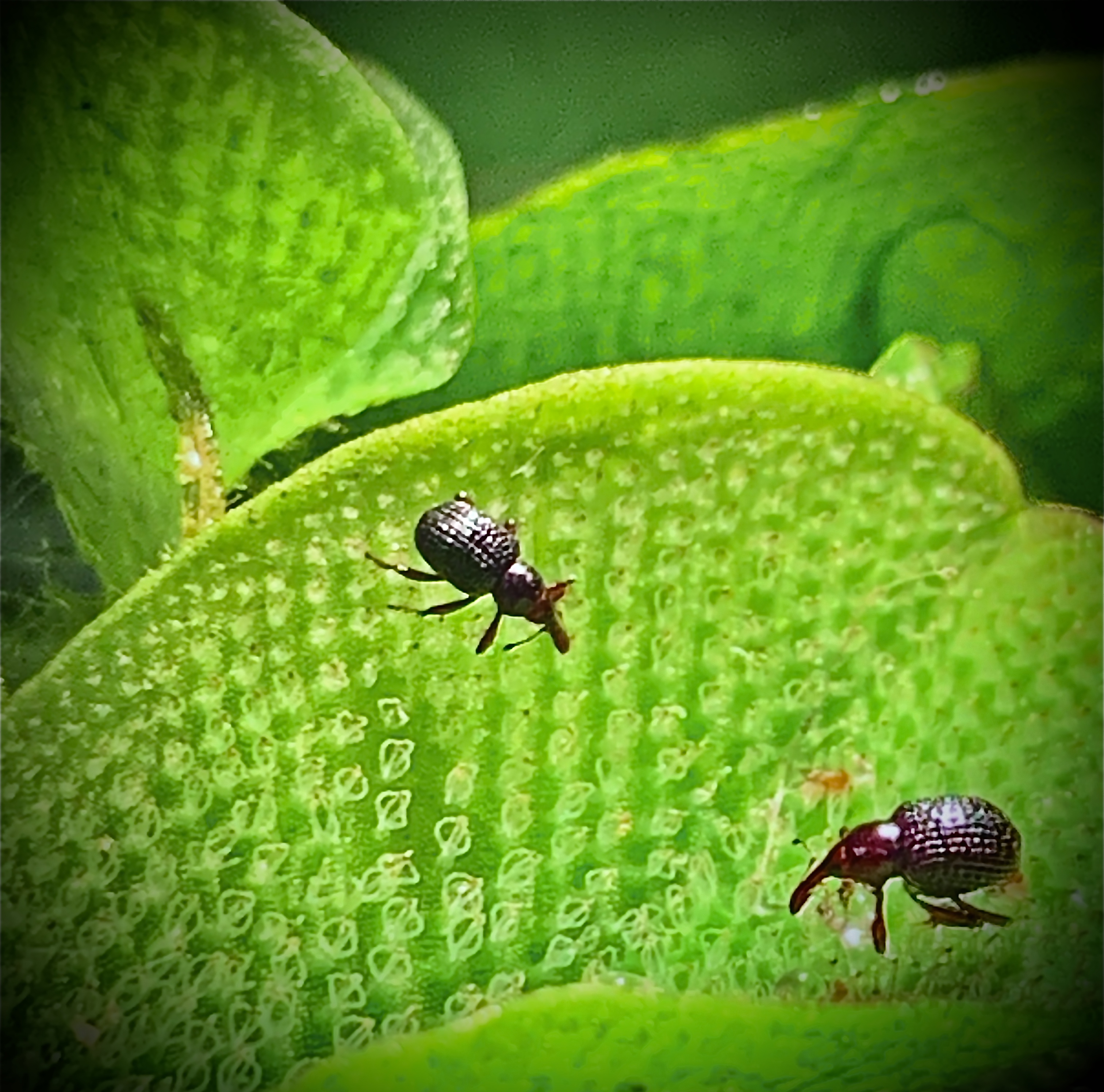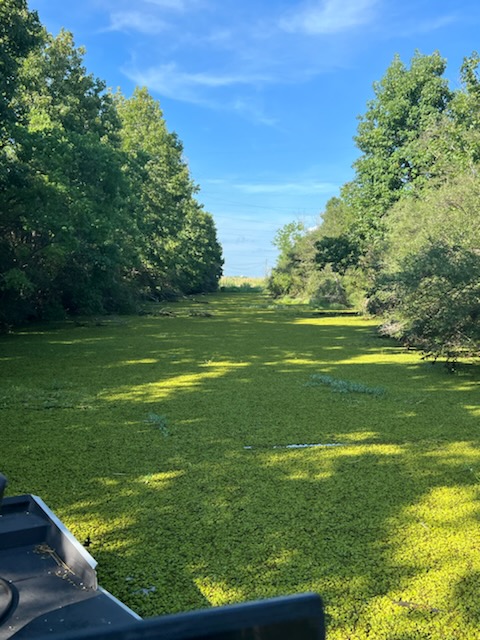
One of the biggest challenges facing Sabine River anglers has met its match in a highly efficient biological agent that shows no mercy, takes no prisoners and helps keep waterways clear. Meet the salvinia weevil, a subaquatic herbivorous insect genetically wired for a Texas-sized task.
We’ll look at this mighty mite more in a moment, but for now, we need to establish its strategic necessity.
Like most shallow, warm fisheries, the Sabine River sees a lot of aquatic plant growth. While native species like eel grass and lily pads contribute to ecological wellness through filtration and habitat for bass and forage, others create more problems than benefits.
Water hyacinth usually comes to mind first, as floating rafts of this invasive plant can clog entire canals, bayous and other backwaters. Certainly a problem for the Texas Parks and Wildlife Department, but even this fast-growing species pales in comparison to the No. 1 aquatic invader beleaguering the Sabine River — giant salvinia.
“Giant salvinia is a lot more aggressive than hyacinth; it can double in acres in seven to 10 days, where hyacinth would be more like 30-45 days,” said TPWD Invasive Species Biologist John Findeisen. “In one week’s time, one football field (of giant salvinia) can become two.”
Profiling the problem
A floating fern of Brazilian origin, Salvinia molesta reached the U.S. through the ornamental plant trade — likely accidental releases from stocked water gardens. According to the U.S. Department of the Interior, a single fragment of giant salvinia introduced into a shallow, nutrient-rich environment can rapidly multiply and form a thick, floating mat called a “sudd.”
As described by the TPWD: Giant salvinia outgrows and replaces native plants, blocks sunlight and decreases oxygen concentrations required by fish and other aquatic animals. When plant masses die, decomposition further reduces dissolved oxygen.
Listed as a Federal Noxious Weed (harmful to agriculture and natural resources) in 1981, giant salvinia is illegal to possess in Texas. Prior to its first discovery in the Houston area and Toledo Bend Reservoir (1998), this plant also known as Kariba Weed, already had a bad rap in countries such as Australia, New Guinea, New Zealand, Zambia, and Zimbabwe.
So, that’s the problem. Here’s the solution
Foreign operators
Expanding our opening military analogy, non-native aquatic plants comprise the invading force. In this conflict, the state has two weapons: one has the potential to annihilate broad areas; another hits specific targets with brutal efficiency.
Herbicides are the former; salvinia weevils, the latter. Considering that giant salvinia came from South America, it makes sense that a specific biological solution would also originate there.
“When we first figured out that we have giant salvinia in the United States, the U.S. Dept. of Agriculture went down to South America to look for biocontrol agents,” Findeisen said. “The weevils were brought back and put into a two- to three-year quarantine process, because the last thing we want to do is bring over a bug that will eat salvinia, but it will also eat our cotton crops, our corn crops, etc.
“As it turned out, this weevil was species-specific to salvinia. I don’t recommend doing this, but you could (hypothetically) take a handful of salvinia weevils throw them into Whole Foods and they’re going to starve to death.”
Simple application: The TPWD raises salvinia weevils in three East Texas hatcheries. When it’s time for deployment, agency biologists load weevil-infested salvinia into 18-gallon totes and transport them to the infiltration site. At adult size, these beneficial bugs are about the size of a pencil lead’s width.
“The weevil larvae cause a lot of the damage,” Findeisen said. “The adults will eat holes in the salvinia leaves, but the larvae burrow into the stem and prevent the plant from being able to move nutrients and water back and forth. That causes the plant to die.”

Battle plan
Findeisen said it can take six to 24 months for a salvinia weevil population to grow large enough — about 35 adults per kilogram of plant mass — to actually control the invasive plant. That’s a lot longer than herbicides, but we’re talking about precision operations that eliminate friendly fire.
“Herbicides are like carpet bombing and salvinia weevils are infantry,” Findeisen said.
Different battlefields require different strategies. As Findeisen explained, the agency bases its decision on the risk to native plants.
“A lot of times, we’re going to use (herbicides and salvinia weevils) together,” Findeisen said. “We’re going to use herbicides to maintain openness. If we have a canal that’s completely choked out, we can come in with herbicides and, within 10-14 days, have that back open.
“There are other places where we have giant salvinia starting to grow and we have a lot of lily pads and other native plants that are beneficial to anglers, fish and all aquatic life. If you go in there with herbicides, we’re going to wipe out a lot of non-target species. That’s too much collateral damage.”
Notably, Findeisen said common salvinia (Salvinia minima) is also present in many of the Sabine’s bayous. It’s typically not as invasive as the giant salvinia, but can still become problematic.
“There are several other non-native species in that area such as alligator weed and even some hydrilla, but both of these species are not problematic and actually provide excellent habitat in conjunction with the native lily pads, water primrose, and burhead species,” Findeisen said. “Since many of these species are mixed in the same areas, TPWD and its contractors must be very careful when applying herbicides as not to create too much collateral damage.
“This is accomplished through the selection of specific herbicides and only treating mats of giant salvinia, common salvinia, and water hyacinth. There are many places in the Orange and Jefferson County areas where you will find a half-dozen or more aquatic plant species growing in the same spot.”
Ongoing campaign
Back to the weevils, Findeisen said natural predation from minnows, bluegill, and dragonfly larvae claim a lot of these planted insects. In areas near the Gulf of Mexico, big storms plunge the waterways and flush out weevil-dense salvinia.
Temperature tolerance is another consideration. With South American lineage, the weevils don’t do well north of Sam Rayburn Reservoir.
“If we have a warm winter, the weevils will do fine, but if we get a cold winter, like we had (2022-23), that wipes out our population, so you’re almost starting over from zero,” Findeisen said. “
On a promising note, Findeisen said the agency has found evidence of increasing weevil resilience.
“We haven’t released weevils in Toledo Bend (the Sabine River reservoir just above the tournament’s upper boundary) since 2017,” he said. “During that time, we’ve had three just crazy cold weather events, including the Texas Snowpocalypse in 2021. At my house, just outside of Lufkin, Texas, we had air temps of 3 degrees, and that’s well below what we thought these weevils could survive.
“With all three cold weather events, what we found on Toledo Bend is that the weevils are surviving. We’d get a cold weather event that would knock the salvinia way back, then we’d go out in the end of April or the beginning of May and we’d find a little bit of salvinia that was kinda beat up. We brought it back and there were weevils on there — a population large enough to control the salvinia.”
At the moment, it looks like giant salvinia isn’t going away anytime soon. Good news is, Texas has a team of diminutive devastators that are ready for battle 24/7. Cold weather, saltwater and natural predation may leave many K.I.A., but anglers can take heart in knowing the TPWD will be sending reinforcements.
The battle continues and the good guys are literally made for this stuff.





